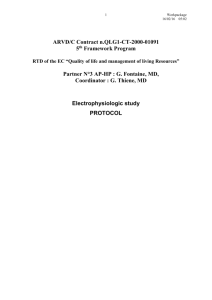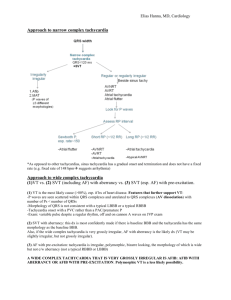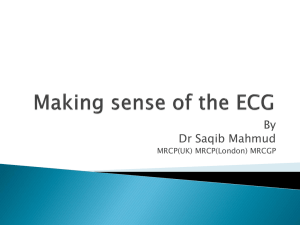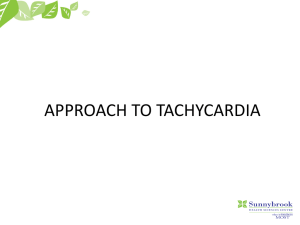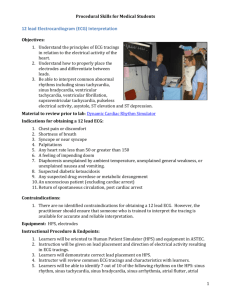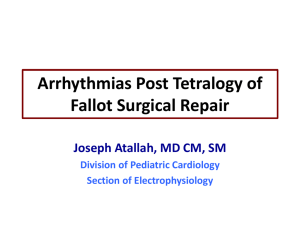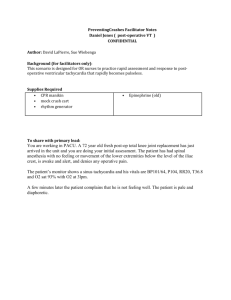FRACP 2002 Cardiology
advertisement
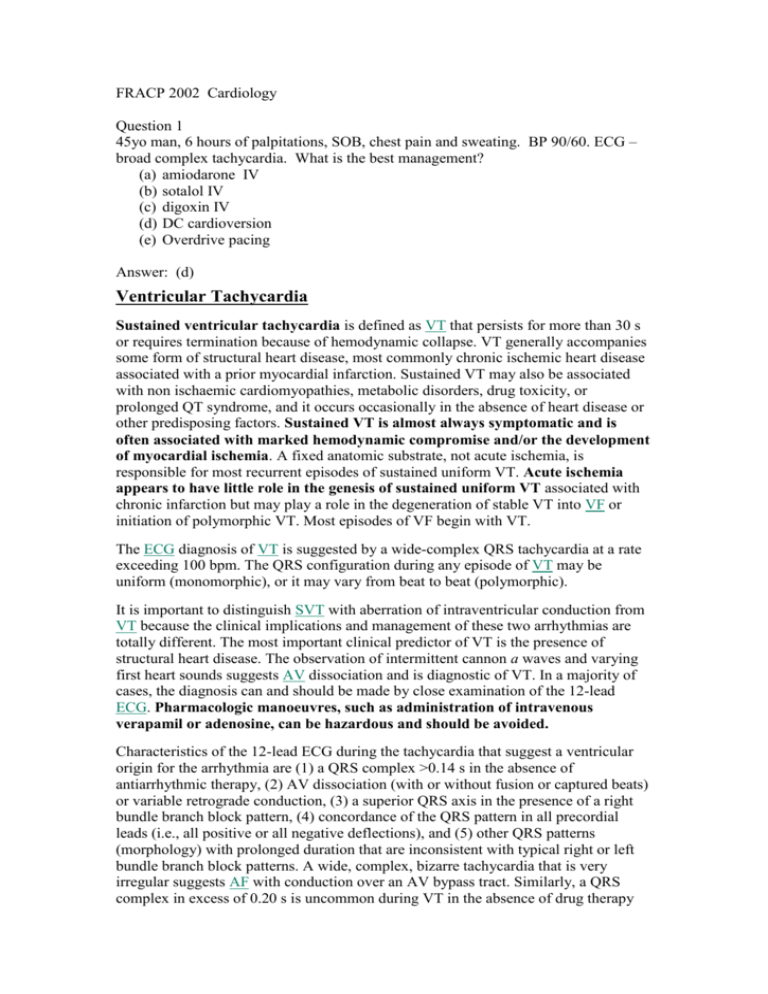
FRACP 2002 Cardiology Question 1 45yo man, 6 hours of palpitations, SOB, chest pain and sweating. BP 90/60. ECG – broad complex tachycardia. What is the best management? (a) amiodarone IV (b) sotalol IV (c) digoxin IV (d) DC cardioversion (e) Overdrive pacing Answer: (d) Ventricular Tachycardia Sustained ventricular tachycardia is defined as VT that persists for more than 30 s or requires termination because of hemodynamic collapse. VT generally accompanies some form of structural heart disease, most commonly chronic ischemic heart disease associated with a prior myocardial infarction. Sustained VT may also be associated with non ischaemic cardiomyopathies, metabolic disorders, drug toxicity, or prolonged QT syndrome, and it occurs occasionally in the absence of heart disease or other predisposing factors. Sustained VT is almost always symptomatic and is often associated with marked hemodynamic compromise and/or the development of myocardial ischemia. A fixed anatomic substrate, not acute ischemia, is responsible for most recurrent episodes of sustained uniform VT. Acute ischemia appears to have little role in the genesis of sustained uniform VT associated with chronic infarction but may play a role in the degeneration of stable VT into VF or initiation of polymorphic VT. Most episodes of VF begin with VT. The ECG diagnosis of VT is suggested by a wide-complex QRS tachycardia at a rate exceeding 100 bpm. The QRS configuration during any episode of VT may be uniform (monomorphic), or it may vary from beat to beat (polymorphic). It is important to distinguish SVT with aberration of intraventricular conduction from VT because the clinical implications and management of these two arrhythmias are totally different. The most important clinical predictor of VT is the presence of structural heart disease. The observation of intermittent cannon a waves and varying first heart sounds suggests AV dissociation and is diagnostic of VT. In a majority of cases, the diagnosis can and should be made by close examination of the 12-lead ECG. Pharmacologic manoeuvres, such as administration of intravenous verapamil or adenosine, can be hazardous and should be avoided. Characteristics of the 12-lead ECG during the tachycardia that suggest a ventricular origin for the arrhythmia are (1) a QRS complex >0.14 s in the absence of antiarrhythmic therapy, (2) AV dissociation (with or without fusion or captured beats) or variable retrograde conduction, (3) a superior QRS axis in the presence of a right bundle branch block pattern, (4) concordance of the QRS pattern in all precordial leads (i.e., all positive or all negative deflections), and (5) other QRS patterns (morphology) with prolonged duration that are inconsistent with typical right or left bundle branch block patterns. A wide, complex, bizarre tachycardia that is very irregular suggests AF with conduction over an AV bypass tract. Similarly, a QRS complex in excess of 0.20 s is uncommon during VT in the absence of drug therapy and is more common with pre-excitation. Intravenous verapamil will stop most recalcitrant SVTs involving the AV junction, but it is rarely effective for VT. Because of this property, verapamil has been utilized to attempt to differentiate SVT with aberrant conduction from VT. However, this is extremely hazardous, since intravenous verapamil can precipitate cardiac arrest in patients with VT. Figure 230-12: Ventricular tachycardia with AV dissociation. P waves are dissociated from the underlying wide complex rhythm (best seen on lead V1). Table 230-5: Wide Complex Tachycardia ECG Criteria That Favor Ventricular Tachycardia 1. AV dissociation 2. QRS width: >0.14 s with RBBB configuration >0.16 s with LBBB configuration 3. QRS axis: Left axis deviation with RBBB morphology Extreme left axis deviation (northwest axis) with LBBB morphology 4. Concordance of QRS in precordial leads 5. Morphologic patterns of the QRS complex RBBB: Mono- or biphasic complex in V1 RS (only with left axis deviation) or QS in V6 LBBB: Broad R wave in V1 or V2 0.04 s Onset of QRS to nadir of S wave in V 1 or V2 of Notched downslope of S wave in V1 or V2 Q wave in V6 0.07 s NOTE: AV, atrioventricular; BBB, bundle branch block. Sustained uniform VT can be terminated by programmed stimulation or rapid pacing in at least 75% of patients; the remainder require cardioversion. The ability to reproducibly initiate and terminate a sustained, uniform VT permits assessment of pharmacologic and electrical therapy of these arrhythmias. The reproducible termination of VT by programmed stimulation permits evaluation of the effectiveness of anti-tachycardia pacemakers for long-term therapy of paroxysmal episodes of arrhythmia. Unfortunately, rapid pacing, the most effective form of therapy, can accelerate the tachycardia and/or produce VF. Therefore, antitachycardia pacing is a viable form of therapy only when the pacing device includes backup defibrillation capabilities. Clinical Features Symptoms depend on the ventricular rate, duration of the tachycardia, and presence and extent of underlying cardiac disease. When the tachycardia is rapid and associated with severe myocardial dysfunction and cerebrovascular disease, hypotension and syncope are common. However, the presence of hemodynamic stability does not preclude a diagnosis of VT. The rate, loss of the atrial contribution to ventricular filling, and abnormal sequence of ventricular activation are important factors producing a decreased cardiac output during VT. The prognosis of VT depends on the underlying disease state. If sustained VT develops within the first 6 weeks following AMI, the prognosis is poor, with a 75% mortality rate at 1 year. Patients without heart disease who have uniform VT have a good prognosis and an extremely low risk of sudden death. Treatment The risk-benefit ratio of treating each specific type of VT should be considered before beginning therapy. This is important because antiarrhythmic agents can produce or exacerbate the very arrhythmias that they are given to prevent. In general, patients with VT but without organic heart disease have a benign course; such patients with asymptomatic, nonsustained VT need not be treated because their prognosis will not be affected. An exception is the patient with congenital long QT syndrome. Such patients have recurrent polymorphic VT and a high mortality from sudden death if untreated. Patients with sustained VT in the absence of heart disease usually require therapy because the arrhythmia causes symptoms. These tachycardias may respond to beta blockers; verapamil; class IA, IC, or III agents; or amiodarone. In patients with VT and: organic heart disease, marked hemodynamic compromise, or if there is evidence of ischemia, congestive heart failure, or central nervous system hypoperfusion, the rhythm should be promptly terminated by dc cardioversion. If the patient with organic heart disease tolerates the VT well, pharmacologic therapy may be tried. Procainamide is probably the most effective agent for acute therapy. It may or may not terminate the tachycardia but almost always slows the rate. In stable patients in whom these drugs do not terminate the arrhythmia, a pacing catheter can be inserted per venously into the right ventricular apex, and the tachycardia can be terminated by overdrive pacing. Anti-tachycardia pacing has been used as a means to terminate tachycardias that have been reproducibly terminated by pacing in the electrophysiology laboratory. Automatic anti-tachycardia pacing devices are not used alone because pacing during VT may accelerate tachycardia, converting a stable arrhythmia into an unstable one and resulting in severe hemodynamic compromise. However, devices combining antitachycardia pacing with an ICD afford a "backup" means of terminating unstable arrhythmias. The advent of endocardial catheter and intraoperative mapping led to the development of surgical techniques for the management of VT. Following operation, >90% of survivors are controlled either off (two-thirds of patients) or on (one-third) antiarrhythmic agents that were previously ineffective in controlling these rhythms. With the development of radiofrequency ablation and refinement of mapping criteria to locate critical sites of the VT circuit, precisely, catheter ablation can be performed as a curative procedure in selected patients. In experienced centres cure of VT in these selected patients approaches 75%.

